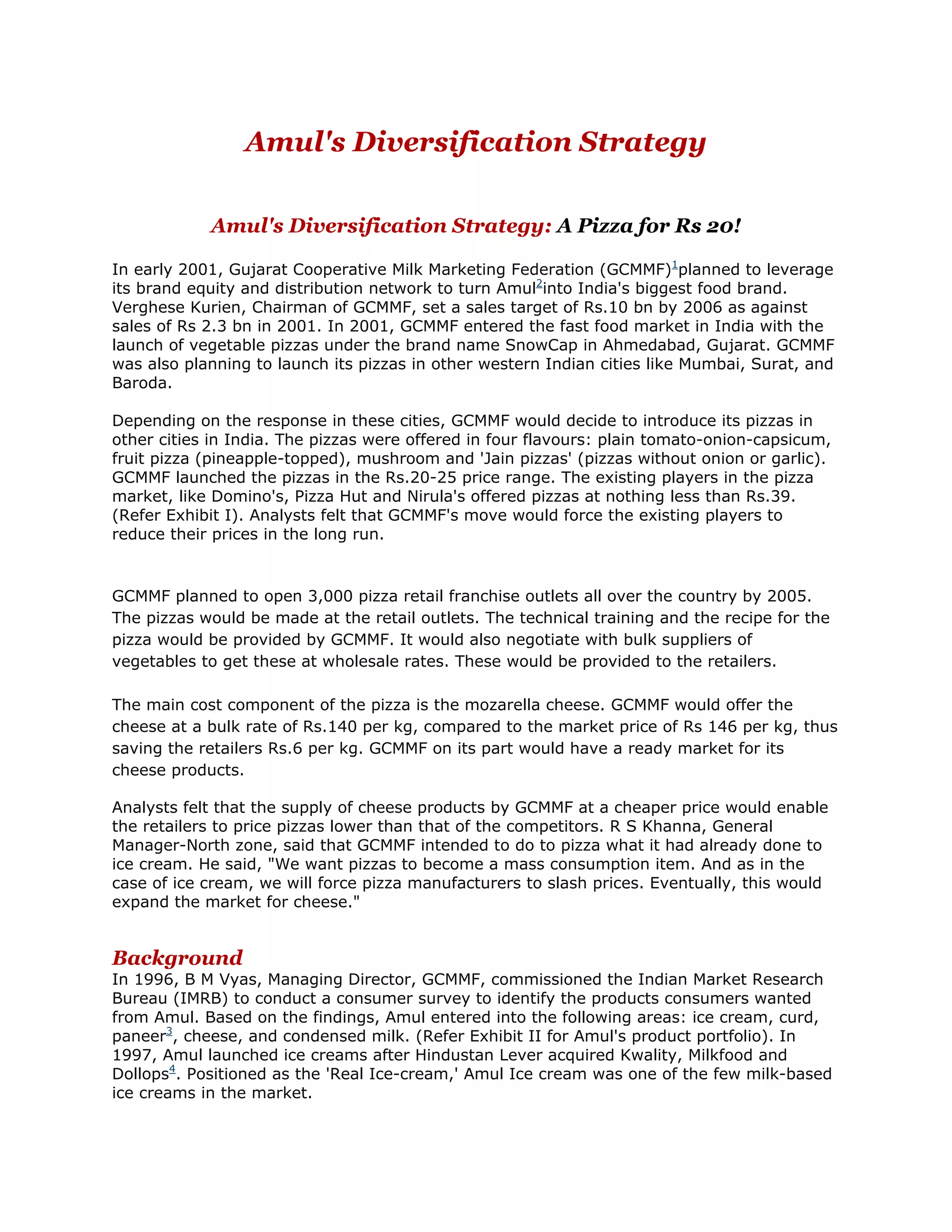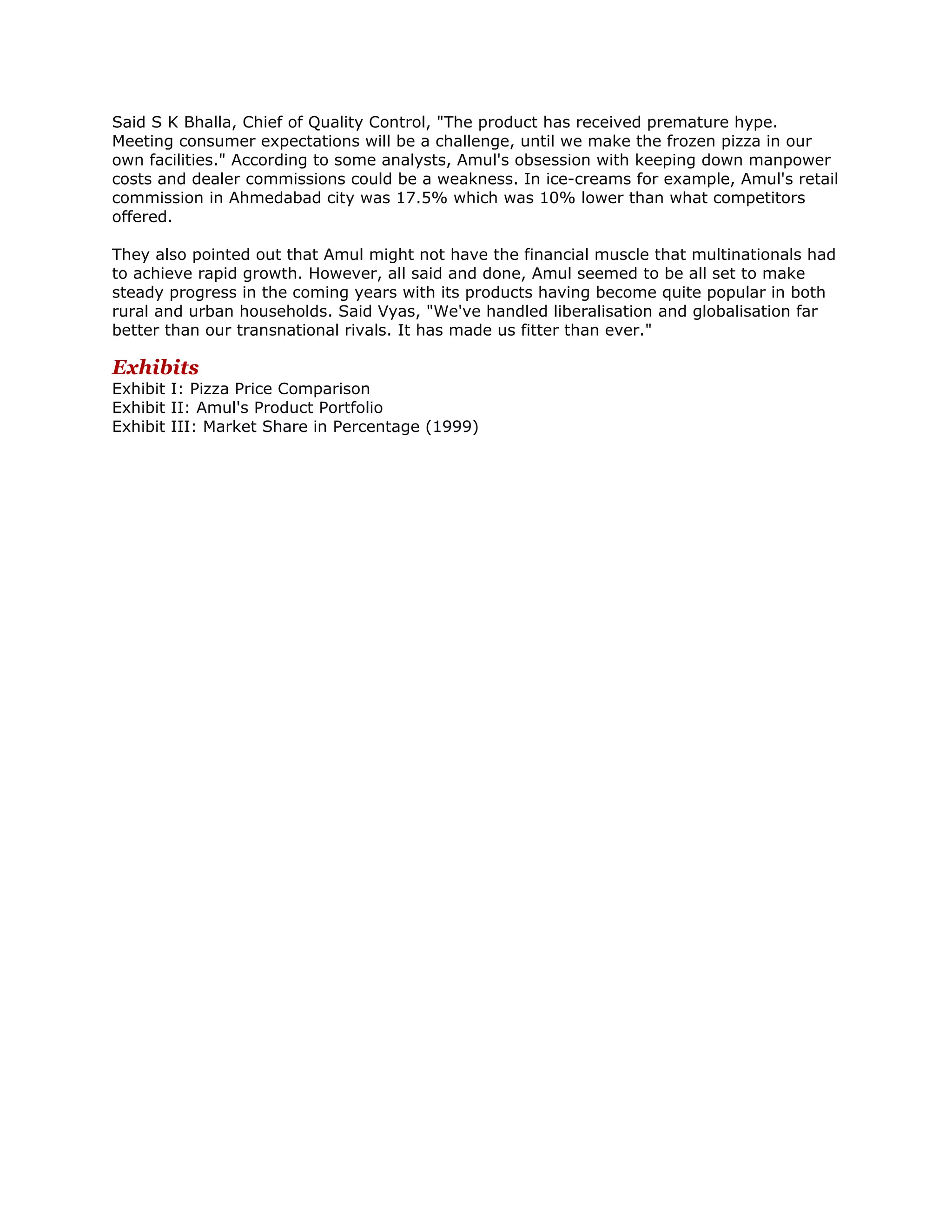GCMMF, which owns the Amul brand, launched vegetable pizzas under the SnowCap brand in 2001 in Ahmedabad, Gujarat priced between Rs. 20-25, much lower than competitors. It planned to introduce pizzas in other western Indian cities and potentially nationwide. GCMMF aimed to open 3,000 pizza retail franchise outlets across India by 2005 to sell the pizzas. A key strategy was supplying mozarella cheese at a bulk discounted rate of Rs. 140/kg compared to Rs. 146/kg in the market, allowing retailers to price pizzas lower than competitors. The goal was to make pizzas as widely consumed as ice cream through low prices that expanded the cheese market.

![With GCMMF gradually expanding its distribution reach, Amul was all set to strengthen its
share in the ice cream segment. (Refer Exhibit III for market share). In August 1999, Amul
launched branded yoghurt in India for the first time, when it test marketed "Masti Dahi" in
Ahmedabad first and then introduced it all over the country. "Masti Dahi" was plain yoghurt
sold in plastic cups. Each 400 gm cup was priced at Rs 12.
In January 2000, Amul re-entered5 the carton milk market6 with the launch of "Amul Taaza"
in Mumbai. Amul Taaza was non-sweetened, plain, low fat milk. The product was positioned
as a lifestyle as well as functional product. It was targeted at the upper middle class
housewife who could use it for different occasions. Amul was targeting sales of about 0.1
mn litres per day. In November 2000, Amul decided to promote mozzarella cheese, which
was used in pizza.
The growing demand for mozzarella cheese from pizza making companies like Pizza Hut and
Domino's Pizza was expected to give Amul's cheese sale an additional push.
1] GCMMF was India's largest food products marketing organisation based at Anand, Gujarat. GCMMF
had annual sales of more than Rs 22 bn in 2000-01. It is a state level apex body of milk cooperatives
in Gujarat. GCMMF has 14 affiliated dairy plants with a total milk handling capacity of 6 mn litres per
day and milk drying capacity of 450 Mt per day. With 12 milk processing units, each located at the
district level, GCMMF has a membership of 2 mn farmers who belong to 10, 000 village dairy co-
operative societies.
2] Amul is the mother brand of GCMMF. 3] Paneer or cottage fresh cheese is made from low fat milk,
without involving long, complicated procedures. It is rich in proteins.
4] In 1993, HLL acquired Dollops Icecream from Cadbury's India. In 1994, BBLIL launched the Wall's
range of frozen desserts. By the end of the year, HLL entered into a strategic alliance with the Kwality
group. In 1995, the Milkfood icecream marketing and distribution rights were acquired by HLL.
5] In 1983, Amul had introduced branded milk in 500-ml tetrahedron-shaped packs priced at Rs.4.50
and one litre rectangular packs at Rs.9. Amul felt that the tetrahedron pack was well ahead of its time,
which was why it was not accepted in 1983. Moreover, the packaging was not convenient and it was
difficult to store.
6] The three main players in the Rs.360 bn packaged milk market are Amul, Nestle and Vijaya. The
market is important to all three. Nestle is looking at a Rs.1.50 bn business from milk alone by 2004.
Amul Taaza is expected to be a Rs.1 bn brand by 2001, and Vijaya could achieve Rs.1.2 bn sales from
packaged milk. Amul is investing Rs.300 mn in two new factories in Andhra Pradesh and Maharashtra.
Nestle is targeting the south as a potential big milk market. Nestle is setting up two more plants
(amount invested yet to be revealed) in the southern region and is aggressive on the price front,
pegging its Pure Milk brand at Rs 20 a litre against Amul Taaza's Rs.22.
7] A flat unleavened bread made from flour, water and clarified butter.
8] A deep-fried fritter made by dipping pieces of vegetable, meat or shellfish in chickpea flour batter
and generally eaten as a snack.
9] Amul's chocolate portfolio includes brands like Amul Bitter, Amul Premium, Amul Crisp, Amul Fruit
& Nut, Amul Badam Bar, Amul Milk and Amul Crunch.
10] Amul followed a strategy of roping in cooperatives to aid growth around the country. Amul ice
cream is now manufactured in seven locations across the country. Pune Milk Cooperative and Akluj
Dairy (near Baramati in Maharashtra) have been roped in to sell 0.2 mn litres of milk per day under
the Amul brand name in Mumbai. In TamilNadu, Salem Dairy has signed up to produce milk and ghee
under the Amul brand name.](https://image.slidesharecdn.com/amulsdiversificationstrategy-120229055112-phpapp01/75/Amul-s-diversification-strategy-2-2048.jpg)

